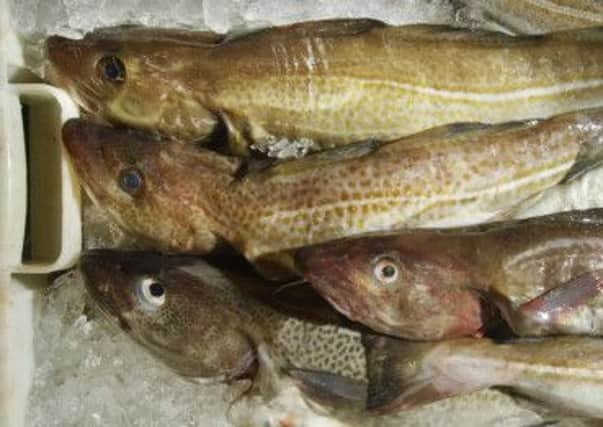Anger as North Sea cod stays on ‘do not eat’ list


The Marine Conservation Society (MCS) has announced that cod is to remain on its list of fish to avoid in the latest edition of of its influential seafood guide.
Earlier this year, expert marine scientists from the International Council of the Exploration of the Sea (ICES) revealed that the biomass - or breeding stock - of North Sea cod is now around three times larger than it was in 2006 and has returned to the same level as 1995.
Advertisement
Hide AdAdvertisement
Hide AdICES are, however, recommending a nine per cent cut in the North Sea cod quota for next year due to fewer young fish reaching maturity.
‘Keep cod off the menu’
The MCS announced: “North Sea cod should remain firmly off the menu, despite an encouraging rise in stocks. The Marine Conservation Society urges consumers to choose a different accompaniment to chips “
An MCS spokeswoman explained: “According to the latest data from ICES, North Sea cod stocks are only slightly above what are considered safe levels for the species, despite a decrease in the amount fished. It is still too soon for North Sea supplies of this iconic fish to be back on our menus, and therefore it remains on the Fish to Avoid list in the latest version of the MCS Fishonline website.”
She continued: “With cod still one of the top five favourite species of fish to eat in the UK, MCS suggests consumers continue to use the Fishonline website to find alternative fish to eat. If it must be cod on your plate, then look out for cod from Marine Stewardship Council (MSC) certified fisheries in the North east Arctic, Iceland or Eastern Baltic which feature on the Fish to Eat list.”
Bernadette Clarke, the conservation charity’s fisheries officer, acknowledged the efforts being made by fishermen to conserve cod stocks, but argued it was too soon to put North Sea cod back on the menu.
She said: “The efforts of fishers and managers have placed cod in the North Sea on the road to recovery. Programmes such as the Conservation Credits Scheme - which rewards fishermen for adopting conservation measures with additional days at sea – together with more effective long-term management plans will hopefully see the fishery continue to recover in the coming years.
“Our advice remains to seek alternatives to North Sea cod. There are more sustainable cod fisheries that we currently rate as Fish to Eat.”
‘Eat more Scottish fish’ call
Bertie Armstrong, chief executive of the Scottish Fishermen’s Federation, hit out at the new advice.
Advertisement
Hide AdAdvertisement
Hide AdHe said: “We firmly believe that North Sea cod is a sustainable choice for the consumer because the scientific advice indicates that stock levels will continue to rise in future, thanks to the sustainable fishing practices adopted by our fishermen.
“Indeed, the majority of stocks of interest to Scottish fishermen are increasing – and important species such as Scottish haddock, saithe and herring are all independently certified by the Marine Stewardship Council for the responsible manner in which they are harvested. Our unequivocal message to the consumer is to eat more Scottish fish – and that includes North Sea cod.”
Mr Armstrong continued: “Whilst we are disappointed that the MCS advice on North Sea cod remains unchanged at the moment, we are pleased that they recognise that the stock is on the road to recovery due to the conservation efforts of our fishermen.”
Scallop fisheries on ‘Eat’ list
The new list has, however, placed six King scallop fisheries, including the MSC certified fishery in Shetland, on the list of seafood to eat for the first time. Haddock from Iceland has also been certified as a Fish to Eat, together with UK seabass, farmed in land-based tanks, and herring trawled in the Irish Sea.
The MCS spokeswoman said: “In recent years, seabass has become a restaurant favourite, but because it’s not classed as a commercial species it does not have a quota, and with no limit to how much can be taken, the stock is now being over-fished.
“Trawled and gillnet caught seabass are both rated 5 on the MCS Fish to Avoid list – the lowest rating possible, whilst seabass caught by handline is now rated as a fish to eat occasionally, and remains the most selective and sustainable fishery for wild-caught fish.
“But you can find guilt-free seabass - UK seabass, farmed in land-based tanks is on the Fish to Eat List and rated 1 - the most sustainable choice for this tasty fish.”
She added: “Monkfish remains a fish to eat occasionally because although fishing effort in the North Sea and West of Scotland is reducing, stocks are declining and there are few appropriate management measures in the fisheries for this species. For those who like scallops, six King scallop fisheries appear in Fishonline for the first time, with those from the MSC certified fishery in Shetland the best choice.”
SCOTLAND’S FISHERIES